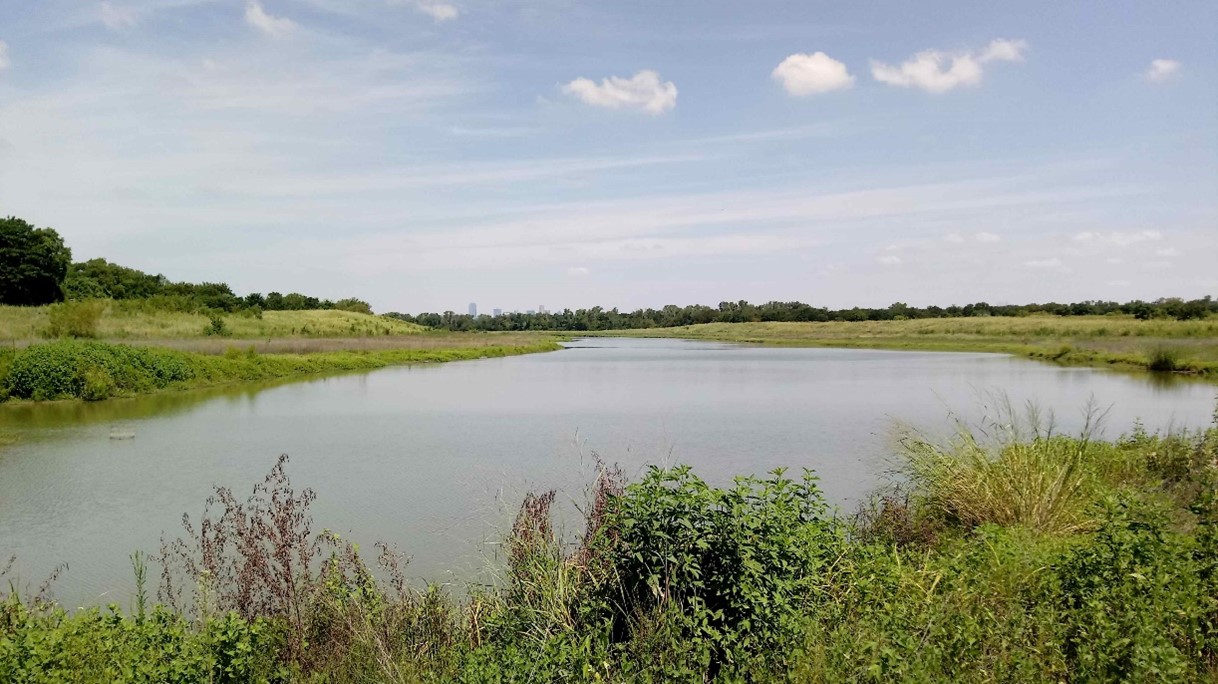-
Home
- Environment
Habitat Creation and Environment
With 10,000 acres and 20 miles of project area, the Trinity River Corridor Project showcases a variety of ecosystems along the river corridor. However, Trinity Watershed Management is responsible for all creeks, ponds, streams, lakes, and water bodies in Dallas.
Already diverse ecological regions are flourishing such as seasonal wetlands, natural wetlands, miles of green space with emerging Blackland Prairie grasslands, plus Cross Timbers forestland and marsh-like habitat for wildlife and birds. The land features gentle topography and rich clay soils both near the river and away from its banks. Deep in the heart of urbanization, the land thrives because Dallas is focused on everything green!


Photo by Sean Fitzgerald Photo by David Worthington
The Great Trinity Forest
Dallas is setting an amazing challenge for future generations, not just within the limits of our City but around the world, by the mere fact that the City owns one of the largest urban bottomland hardwood forests in America, if not the largest forest all within city limits. A strategic decision was made before the 1998 and 2006 bond programs for Dallas to acquire the forest and become its steward. As this forest matures and is allowed to change with the seasons, Dallas will become the envy of many cities because of this beautiful resource. It will help to shape a new future as plans unfold to nurture the land and forest creating unexpected outdoor venues and gathering places for the public.
The forest begins near Moore Park Gateway in the shadows of downtown Dallas at the Santa Fe Trestle Trail and it continues south past IH-20. The Great Trinity Forest was actually created by the spring flooding of the nearby Trinity River. In the 1940s, as Dallas transitioned from farming to an urban landscape, the cotton and grain fields in the floodplain were abandoned and the river floods slowly began depositing seeds from upstream trees onto the fallow farm fields and in the abandoned neighborhoods.

Green Ash grove in the Great Trinity Forest
Photo By: Michael Wilson
The Great Trinity Forest is composed of:
- 1,410 acres of non-forested land (grassland)
- 4,677 acres of forested land
- 1,001 acres of Management Stands
This forest is the last old growth bottomland hardwood forest in North Central Texas, and it is believed to be the largest urban bottomland hardwood forest in the nation. There are giant Bur Oak, Cedar Elm, Cottonwood, Pecan, Post Oak, Live Oak, and Bois d'arc trees, as well as picturesque ponds and meadows. Once, the forest was home to large mammals such as deer, buffalo, and bear as well as small forest animals. Today, the forest shelters more than 100 native and migratory bird species and provides habitat for primarily small forest animals.
Wetlands in the Forest
Fostering Texas' wetlands, both natural and manmade, are among its most valuable resources. These lands provide many economic and ecological benefits, including flood control, improved water quality, harvestable products, and habitat for Texas' abundant fish, shellfish and wildlife resources. If future generations of Texans are to enjoy the same economic vitality and quality of life as past and present generations, effective strategies must continue to build additional wetlands in Dallas.
Looking north across the wetlands to the downtown skyline.

Cages protect water lilies and pickerel weed, native emergent aquatic plants, from turtles and other dangers at the Lower Chain of Wetlands.
Photo By: Harry Rumberger
The Chain of Wetlands in the Great Trinity Forest (GTF) are functioning and impacting upstream floodwater levels by as much as one foot during heavy rain. They serve the dual purpose of flood protection and habitat creation as well as providing a future economic stimulus for South Dallas in terms of recreation options. This system of wetlands stretches from Great Trinity Forest Way (Loop 12 ) north of I-45 to Moore Park and the Trestle Trail.
Natural wetlands are attractive areas that provide long- and short-term water storage and the dissipation of floodwaters. The Dallas Floodway Extension (DFE) Chain of Wetlands provides new reservoirs for water storage and a secondary flowage path for flood waters along the west side of the Trinity River from Corinth to Loop 12. This secondary flowage path for floodwaters comes into use multiple times a year when the Trinity River leaves its banks, providing nutrients and soil for the wetland's flora and fauna.
Instead of the normal flood water swale that holds water and allows it to gradually infiltrate the soil or be removed by evaporation or pumping, the U. S. Army Corps of Engineers planned the additional feature of creating these artificial yet fully functional wetlands to hold water at all times. Each cell of the chain of wetlands is kept full of water year-round by reusing purified wastewater. A defined center channel and a control structure (weir gate) on each cell allow the City of Dallas to raise or lower the level of water, mimicking the natural, seasonal variations in water levels as well as creating a gentle flow through the cell (a feature important for keeping the mosquito population in check). The wetlands are also tiered, allowing the importation of various aquatic vegetation types.
Aquatic plants in the Chain of Wetlands
This voluntary conservation of the land and restoration of the quality of the environment around it through the Trinity River Corridor Project will serve many generations of Texans.
